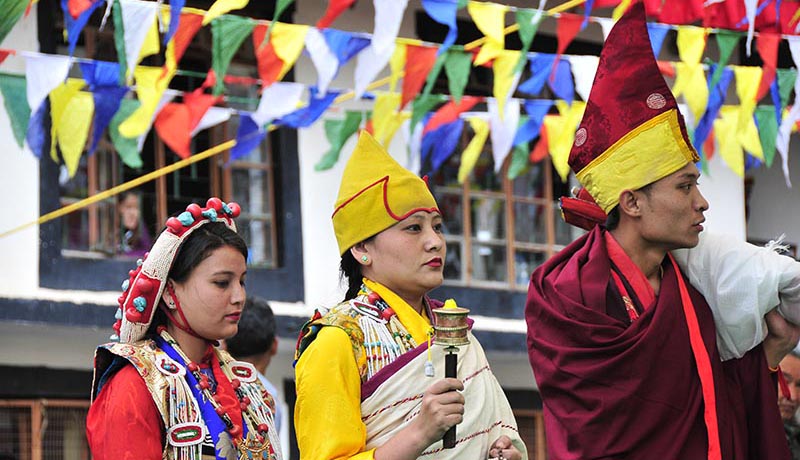In this story, a non-Buddhist king in India is on his way to make blood sacrifices to his god when he sees a beautiful low-caste maiden collecting water. He becomes infatuated with her and takes her for his queen, despite the dire warnings of his clairvoyant talking parrot. As the story goes, a hunter in pursuit of a pig comes across an extraordinarily beautiful maiden coming to fetch water. The hunter thinks to tell the king of her, hoping for a reward if the king takes her for his bride. Although the maiden, who was Sukyi Nyima, refuses to answer any of his questions, the hunter reports her presence to the king. The king, accompanied by the hunter, sets off to see for himself. Agreeing that she was the most beautiful woman he had ever seen, the king makes repeated attempts day after day to engage her in conversation, but to no avail.
SUKYI NYIMA

Finally, they follow her and see that she is living a religious and ascetic life with her yogi guru. After much persuasion, the yogi agrees to let Sukyi Nyima be taken by the king for his bride, although it is against her will. The yogi secretly gives her a special rosary for her protection, and she leaves for the palace to be married to the king.
The king adopts the Buddhist path, and when he no longer pays the first queen any attention, she becomes resentful of Sukyi Nyima. A woman in the queen’s retinue then offers to help her get her own way. The woman, skillful in dance and singing, uses her charms to inveigle herself into the king’s inner circle. There she wins the trust of Sukyi Nyima and cleverly manages to exchange the protection rosary for a lookalike fake. With the protection removed, she drugs the king and his entourage. While they are unconscious, she kills his extraordinary elephant and makes it so that the blame falls on Sukyi Nyima. When this and other ruses do not convince the king, she kills the king’s own son and smears Sukyi Nyima with his blood.
The king is angry but is unable to kill his beautiful queen. Instead, she is given to three butchers to be dragged off to a cemetery and cut to pieces. However, they too are unable to kill her and cut her free from the cemetery slab.
Sukyi Nyima wanders abroad and makes her way to her guru’s hut, which she finds in ruins. The guru had died and only his relics remained, worshipped by the animals. She stays there for many years engaged in meditation.
Finally, she receives a vision of her guru, who tells her to go among the people and teach the Dharma. Disguising herself as a low beggar woman, she teaches the Dharma in the towns and cities until finally the first queen, in a state of regret for her deeds, confesses, though unaware that she is confessing to Sukyi Nyima. However, a wise minister recognizes her and informs the king that Sukyi Nyima is still alive. The king is overjoyed. Sukyi Nyima becomes queen again, and after a while, a son is born. When he grows up, the king is persuaded to become a monk. The son becomes king and Sukyi Nyima and the former king go off to a remote monastery and spend their lives in meditation.
Some say this play is based on the Indian play Sakuntalā, which we adapted from the Mahabharata by Kālidāsa, but there seems little resemblance. However, the prologue states: “The story of brahman Sukyi Nyima whose message is to urge those of great desire to renounce samsara, was translated into Tibetan long ago by Lotsāwa Vairocana and She’u Lotsāwa . This version follows the translation of She’u Lotsāwa.” Moreover, there are Sanskrit references in the story and one or two Sanskrit names. Others say it was composed by a lama from southern Tibet who, of course, may have been familiar with Sanskrit.










